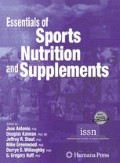Abstract
Voluntary contraction of skeletal muscle increases the demand for oxygen and fuels such as glycogen and fatty acids. Whereas fuels are conveniently stored within muscle cells close to the mitochondria and contractile machinery, there is practically no oxygen reserve in muscle cells and the small amount found in the blood can sustain resting aerobic metabolism only for a few minutes. When muscles contract, they need more oxygen, and whole body oxygen consumption can increase by 10- to 20-fold. The circulatory and the pulmonary systems work together to increase oxygen transport in a highly responsive and coordinated manner. By performing specific exercises consistently for weeks, months, or years, an athlete can stimulate the cardiovascular system to adapt specifically to them. Presented in this chapter is a discussion of the cardiopulmonary responses to a single exercise bout, called the acute response to exercise, as well as chronic adaptations of the cardiovascular system to the many different demands of sport.
Access this chapter
Tax calculation will be finalised at checkout
Purchases are for personal use only
Preview
Unable to display preview. Download preview PDF.
References
Wilmore JH, Costill DL. Physiology of Sport and Exercise. Champaign, IL: Human Kinetics; 1999.
Powers SK, Howley ET. Exercise Physiology. Theory and Application to Fitness and Performance. New York: McGraw-Hill; 2001.
Plowman SA, Smith DL. Exercise Physiology for Health, Fitness, and Performance. San Francisco: Benjamin Cummings; 2003.
McArdle WD, Katch FI, Katch VL. Exercise Physiology. Energy, Nutrition, Performance. Baltimore: Lippincott, Williams & Wilkins; 2001.
Aaron EA, Seow KC, Johnson BD, Dempsey JA. Oxygen cost of exercise hyperpnea: implications for performance. J Appl Physiol 1992;72:1818–1825.
Gardner GW, Edgerton VR, Barnard RJ, Bernauer EM. Cardiorespiratory, hematological and physical performance responses of anemic subjects to iron treatment. Am J Clin Nutr 1975;28:982–988.
Chernecky CC, Berger BJ. Laboratory Tests and Diagnostic Procedures. Philadelphia: W.B. Saunders; 2004.
Tokish JM, Kocher MS, Hawkins RJ. Ergogenic aids: a review of basic science, performance, side effects, and status in sports. Am J Sports Med 2004;32:1543–1553.
Anonymous. Olympics: tests throw up six more drug cases. New Zealand Herald; 2004.
Holloszy JO. Biochemical adaptations in muscle. Effects of exercise on mitochondrial oxygen uptake and respiratory enzyme activity in skeletal muscle. J Biol Chem 1967;242:2278–2282.
Essen B, Jansson E, Henriksson J, Taylor AW, Saltin B. Metabolic characteristics of fibre types in human skeletal muscle. Acta Physiol Scand 1975;95:153–165.
Andersen P, Saltin B. Maximal perfusion of skeletal muscle in man. J Physiol 1985;366:233–249.
Dempsey JA, Harms CA, Ainsworth DM. Respiratory muscle perfusion and energetics during exercise. Med Sci Sports Exerc 1996;28:1123–1128.
Zhou B, Conlee RK, Jensen R, Fellingham GW, George JD, Fisher AG. Stroke volume does not plateau during graded exercise in elite male distance runners. Med Sci Sports Exerc 2001;33:1849–1854.
Gledhill N, Cox D, Jamnik R. Endurance athletes’ stroke volume does not plateau: major advantage is diastolic function. Med Sci Sports Exerc 1994;26:1116–1121.
Rowell LB, O’Leary DS, Kellogg DL Jr. Integration of Cardiovascular Control Systems in Dynamic Exercise. New York: Oxford University Press; 1996.
Blomqvist CG, Saltin B. Cardiovascular adaptations to physical training. Annu Rev Physiol 1983;45:169–189.
American College of Sports Medicine. Guidelines for Exercise Testing and Prescription. Baltimore: Williams & Wilkins; 2000.
Barcroft H, Millen JLE. Blood flow through the muscle during sustained contractions. J Physiol 1939;97:17–27.
MacDougall JD, Tuxen D, Sale DG, Moroz JR, Sutton J. Arterial blood pressure response to heavy resistance exercise. J Appl Physiol 2000;58(3):785–790.
Fleck SJ, Kraemer WJ. Designing Resistance Training Programs. Champaign, IL: Human Kinetics Publishers; 2004.
Hickson RC, Foster C, Pollock ML, Galassi TM, Rich S. Reduced training intensities and loss of aerobic power, endurance, and cardiac growth. J Appl Physiol 1985;58(2):492–499.
Puffer JC. Overview of the athletic heart syndrome. In: Thompson PD, ed. Exercise and Sports Cardiology. New York: McGraw-Hill; 2001:30–42.
Chilibeck PD, Syrotuik DG, Bell GJ. The effect of strength training on estimates of mitochondrial density and distribution throughout muscle fibres. Eur J Appl Physiol Occup Physiol 1999;80:604–609.
McCall GE, Byrnes WC, Dickinson A, Pattany PM, Fleck SJ. Muscle fiber hypertrophy, hyperplasia, and capillary density in college men after resistance training. J Appl Physiol 1996;81:2004–2012.
Montgomery HE, Marshall R, Hemingway H, et al. Human gene for physical performance. Nature 1998;393:221–222.
Frederiksen H, Bathum L, Worm C, Christensen K, Puggaard L. ACE genotype and physical training effects: a randomized study among elderly Danes. Aging Clin Exp Res 2003;15:284–291.
Editor information
Editors and Affiliations
Rights and permissions
Copyright information
© 2008 Humana Press. a part of Spring Science+Business Media, LLC
About this chapter
Cite this chapter
Seip, R. (2008). Cardiovascular and Pulmonary Responses to Exercise. In: Antonio, J., Kalman, D., Stout, J.R., Greenwood, M., Willoughby, D.S., Haff, G.G. (eds) Essentials of Sports Nutrition and Supplements. Humana Press. https://doi.org/10.1007/978-1-59745-302-8_4
Download citation
DOI: https://doi.org/10.1007/978-1-59745-302-8_4
Publisher Name: Humana Press
Print ISBN: 978-1-58829-611-5
Online ISBN: 978-1-59745-302-8
eBook Packages: Chemistry and Materials ScienceChemistry and Material Science (R0)

